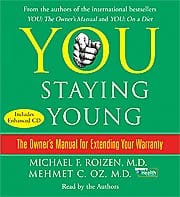Life Extension Magazine®
In best-seller after best-seller, Drs. Mehmet Oz and Michael Roizen use their popular books as a vehicle to dispense the latest scientific research and medical findings in a format aimed at educating both patients and doctors with practical information on how to live longer, healthier lives. Without hesitation, Drs. Oz and Roizen tackle dense but critical topics such as mitochondrial dysfunction and the role it plays in accelerated aging and translate this into information that appeals to a wide audience. Below is a brief excerpt of some of the material contained in their essential guide to successful longevity, You: Staying Young: The Owner’s Manual for Extending Your Warranty. Strategic AgingTo add serious years to your life—and life to your years—you have to lower your risk for all diseases. And the only way to do that is to slow your rate of aging on the cellular level. Curing cancer or any other disease does not necessarily do anything to change the nature or speed of your bodily aging process. That’s because aging and disease—although they interact with each other—aren’t the same thing. As we grow older, all of our systems slowly deteriorate, which makes us more vulnerable to disease. By slowing the aging of our cells while simultaneously preventing disease, we can enjoy not only a higher quality of life but a much longer one as well. Because there are huge delays between the cause of the problem and the effects you actually see in your life you have to start building defenses in your thirties, forties, and fifties against attacks that may not occur until your sixties, seventies, and eighties.
Just because you’ve been dealt a genetic hand that predisposes you to heart disease or diabetes doesn’t mean that you can’t mitigate the effects of those genes. While you can’t change your genes, you can change whether they are turned on or off, or how you express them. Not every aggressive detrimental gene needs to be turned on, and not all of your sleepy protective genes have to remain dormant. Despite what you think, aging—in the traditional way that we think of it, with everything slowly and painfully shutting down—isn’t ‘meant to be.’ The real secret to longevity isn’t whether or not you break; it’s how well you recover and repair when you do. Our bodies, in fact, weren’t designed not to break down (legs as thick as redwoods may not break, but they wouldn’t be very nimble). They were designed with a great efficacy and ability to repair themselves. Aging is essentially a process in which your cells lose their resilience; they lose their ability to repair damage because the things like mitochondria and telomeres, aren’t working the way they should. But it’s within your power to boost that resilience and keep your vehicle going an extra couple hundred thousand miles.
It means that aging is really about the rate of aging—specific-ally, how the outside and inside factors accelerate or decelerate your aging. Here’s the big secret about aging: your rate of aging doubles every eight years. So, if we were able to maintain a forty-year-old’s rate of aging for the rest of our lives, we would live past age one hundred twenty and ‘die of old age.’ While inside out and outside in both play a role—and both influence each other—your job is to try to manage both forms, so that you slow the real culprit in growing old: the rate of aging. The truth about aging is that you—right now—have the ability to live 35% longer than expected (today’s life expectancy is seventy-five for men and eighty for women) with a greater quality of life and without frailty. That means it’s reasonable to say that you can get to one hundred or beyond and enjoy a good quality of life along the way. While relying on the talents, skills, and knowledge of others may get you out of a medical jam, what you really want is to avoid it in the first place. Restricting calories, increasing your strength, and getting quality sleep are three of nature’s best antiaging medicines. Together, these activities—as well as the other actions we recommend—control 70% of how well you age. The telomeres of people who feel more stressed are almost 50% shorter than people who say they’re less stressed. Since scientists have a rough idea what the average telomere length is for a specific age, they can estimate how much older the higher-stress group is biologically: a whopping nine to seventeen years. Just by thinking they are aging faster, they actually aged faster. So how do you change the function of your genes? One way is through the rebuilding of chromosomes. Your chromosomes have small substances on the ends called telomeres. Think of them as being like those little plastic tips of shoelaces. Every time a cell reproduces, that telomere gets a little shorter, just as the shoelace tip wears off with time. Nerve cells communicate with one another via neurotransmitters, chemicals that ferry information from neuron to neuron across the synapses between them. The most common neurotransmitter is called acetylcholine. When levels of this chemical fall, especially in the hippocampus (the part of the brain that controls our memory), we develop cognitive impairment. Many of the treatments for Alzheimer’s are aimed at increasing the amount of acetylcholine in the brain. The other chemical that plays a significant role in memory is called brain-derived neurotrophic factor (BDNF, or just neurotrophins if you prefer), which works like Miracle-Gro for your brain. During infancy, BDNF helps develop nerves that help us learn, but as we get older, things like inflammation and stress can decrease its levels. Research shows that you can do things to improve your levels of BDNF, such as consuming the spice curcumin (a component of turmeric), restricting calories, doing exercise, being in love, and taking some of a class of antidepressants known as selective serotonin reuptake inhibitors, or SSRIs. Enhance Your Brain FunctionFeed on brain food. While physics would dictate that your food travels down after you eat it, a certain amount travels up to your brain (via arteries after it’s been through the digestive process, of course). Among the best nutrients to help keep your cerebral power lines strong are omega-3 fatty acids—the kinds of fat found in fish like salmon and mahi-mahi. These healthy fats, which have been shown to slow cognitive decline in people who are at risk, not only help keep your arteries clear but improve the function of your message sending neurotransmitters. Aim for 13 ounces of fish a week, or, if you prefer supplements, take 2 grams of fish oil a day (molecularly distilled), or DHA from algae (where fish get their omega-3s), or an ounce of walnuts a day. DHA is the omega-3 that seems best for the brain. Several substances have been shown to help cognitive function. These are the ones we recommend:
Mitochondrial Health
Mitochondria (you have hundreds of those per cell) convert nutrients from the food you eat into energy that your body uses in order to perform all of the functions it needs to. They are the fundamental drivers of metabolism. They make sure that what you eat fits into how you perform. Plus, their function (and dysfunction) serves as the backbone for one of the major theories of aging. The problem is, when mitochondria turn your food into energy, they produce oxygen free radicals—molecules that cause dangerous inflammation in the mitochondria themselves as well as in the rest of the cell when they spill over. Think of them as the power plants of our bodily city. Just like an old factory, aging mitochondria spill more industrial waste into the environment. The damage this inflammation causes to your cells and to the mitochondria within your cells is responsible for many age-related problems. This oxidation, for example, is what causes a “rusting” of your arteries, which is some of what ages your cardiovascular system. So let’s take a closer look at how mitochondria work. You have hundreds of mitochondria per cell and dozens of strands of mitochondrial DNA per mitochondrion. That means that every cell contains thousands of strands of mitochondrial DNA. If your body can’t produce energy efficiently, it means that mitochondria are not getting the most energy out of the oxygen and sugar that their furnaces are fed. So even if you have good nutrition in what you eat, lower levels of your body’s energy currency, called ATP (adenosine triphosphate), are made. We know that mitochondrial damage in the heart happens when your body no longer consumes oxygen and glucose efficiently. We also see mitochondrial damage in brain-related disease and in diabetes, where it influences the pancreas’s ability to make insulin. In fact, mitochondrial damage may serve as a contributing factor to certain types of cancer, because the more oxidative damage that takes place, the more DNA is damaged, and the damaged DNA, when it’s replicated over and over again, can evolve into a cancer. To order You: Staying Young: The Owner’s Manual for Extending Your Warranty, by Michael F. Roizen, MD, and Mehmet C. Oz, MD, please click or call 1-800-544-4440. Retail price $26, member price $18.20. |




